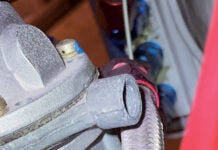 You know that summer is here when you see shy fuel tanks, basking in the sun!
You know that summer is here when you see shy fuel tanks, basking in the sun!
In this case, we were able to capture the image of our Dream Tundra fuel tanks, stripped out of the airplane and catching some rays to set up Pro-Seal patches on some leaking welds. It’s all part of experimental aircraft ownership especially ownership of a kit or plans-built that doesn’t have a lot of examples flying. The Tundra is a good workhorse, but we are discovering a few bugs – and the fuel tanks appear to have a couple. We’ve seen leaks at the welded edge seams, as well as leaks from some spot welds that hold the internal stiffeners/ribs in place. Unfortunately, consulting with other owners of flying Tundras has shown that we are not alone – similar tank leaks have cropped up on a number of other operational planes, and have been dealt with in a number of ways.
Dream recommends having the seams re-welded, and if we had an aircraft-quality aluminum welder handy, we might have done that. Some owners have had replacement tanks fabricated by Dream, and sent out. We are pursuing that approach, but at the same time, have adopted the “Pro-seal the heck out of it” approach to see if we can keep flying while waiting on Dream. While the best way to apply Pro-Seal (Polysulfide Sealant) is to the inside of a tank, its just not feasible in this case – so we made U-shaped aluminum clips that go on over the welds on all of the edge seams, pre-sealed the seams, clipped the aluminum over the Pro-seal, then slathered on more Pro-seal. The spot welds were roughed up with a blue Scotchbrite wheel, cleaned, then daubed with the gray goo.
A little bright sunshine helps the cure of the nasty stuff – so out into the sun they go to catch some rays. Reinstallation will come when I am happy with the cure. We’ll let you know if the 100LL starts seeping again.
A day in the life – catching some sunshine, then back to work!













